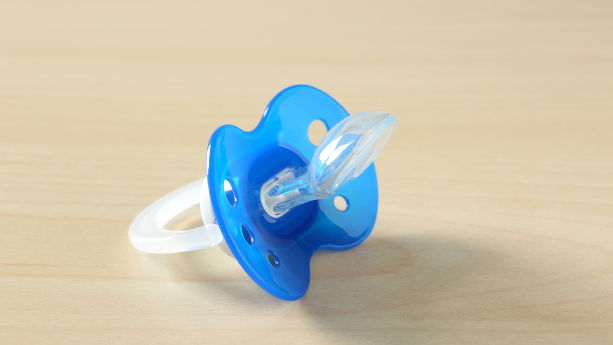
Baby pacifiers, teats, and similar products are subject to strict safety standards and substance restrictions. In this guide, we explain the main requirements of relevant regulations such as the Teats and Soothers Directive, the General Product Safety Regulation, REACH, and more.
We also explain why you should not assume that pacifiers manufactured outside the EU are designed to comply with European Union safety requirements.
Content Overview

FREE CONSULTATION CALL (US, EU & UK)
- Request a free 30-minute call with Ivan Malloci to learn how we can help you with:
- Find product requirements
- Certification and labeling
- Lab testing
Teats and Soothers Directive 93/11/EEC
Directive 93/11/EEC sets restrictions regarding the release of N-nitrosamines and N-nitrosatable substances from teats and soothers made from rubber or elastomer.
It states that rubber or elastomer teats and soothers should not release these substances on “saliva test solution” at levels exceeding the following amounts:
- N-nitrosamines released – 0.01 mg/kg
- N-nitrosatable substances released – 0.1 mg/kg
Additionally, Annex I sets rules for testing the release of N-nitrosamines and N-nitrosatable substances from teats and soothers.
General Product Safety Regulation
The General Product Safety Regulation (GPSR) sets safety requirements for consumer products, including pacifiers. It also sets labelling and documentation requirements.
There are two harmonised standards for soothers and soother holders:
a. EN 1400 – Child use and care articles – Soothers for babies and young children – Safety requirements and test methods
b. EN 12586 – Child care articles – Soother holder – Safety requirements and test methods
Note that harmonised standards provide a presumption of conformity with the requirements of the regulation.
EN 1400 – Child use and care articles. Soothers for babies and young children
EN 1400 applies to soothers and products resembling and functioning as soothers, for babies and children. It sets requirements regarding the following for soothers:
- Materials
- Construction
- Performance
- Packaging
- Product information
The standard does not apply to specialist medical products and feeding teats.
EN 12586 – Child use and care article – Soother holder
EN 12586 covers soother holders and components meant to connect said soothers to other products, such as straps. This standard sets requirements regarding the following for such products:
- Materials
- Construction
- Performance
- Packaging
- Product information
It also contains test methods for chemical and mechanical requirements.
The standard page on the CENELEC website also notes that if the soother holder has play value, it must comply with the Toy Safety Directive.
Design for compliance
EN 1400 and EN 12586 cover construction and mechanical properties that affect external and internal product design elements. It’s therefore essential that your product designer has a thorough understanding of the practical aspects of all applicable pacifier standards.
Otherwise, you are at risk of producing a pacifier that is inherently non-compliant by design. Ensuring product compliance starts at the drawing board.
Traceability information
The GPSR mandates pacifier or soother manufacturers to provide traceability information on their products, which includes:
- Product type, batch, and serial number
- Manufacturer’s name or registered trade mark
- Manufacturer’s postal and electronic addresses
Warnings
Manufacturers must provide the following on their product or packaging:
- Relevant warnings for end users
- Instructions for safe use and disposal
- Age suitability labelling
Notice that there are no examples of warning texts within the GPSR – but you may be able to find warning text examples in product standards.
Risk assessment report
A risk assessment report is intended to describe the type of hazards that might be caused by the product – and the course of action taken by the seller in case something goes wrong. In the case of a pacifier, it might include the following:
a. Chemical hazards, due to excessive migration of dangerous chemicals
b. Strangulation hazards, due to a pacifier’s holder that, for example, includes a long string
Importers and manufacturers should provide this document to the authorities in the case of safety issues or recalls.
User instructions
User instructions should include information such as the following:
- Assembly instructions
- Installation instructions
- Maintenance instructions
- Disposal instructions
- Safe use instructions
Technical documentation
The GPSR requires manufacturers to draw up technical documentation for their products, which includes:
- General product description
- Essential characteristics for testing product safety
- Risk analysis specific to the product
- Adopted solutions to mitigate or eliminate risk
- List of relevant EU standards
- List of other measures (e.g., guidelines)
- Test reports
Test report
You must ensure that your products comply with the technical requirements of the GPSR. As such, you should have your products tested to prove compliance. In this case, testing is mandatory.
If your products pass testing, you receive a test report proving your products’ compliance with the requirements. Such test reports must be attached to the technical documentation.
Toy Soother Holder: Toy Safety Directive
The Toy Safety Directive regulates toys and products with “play value”. Thus, pacifier holders with a “play value” fall under the directive’s scope.
As a pacifier is normally not a toy, it might sometimes be difficult for importers or manufacturers to determine whether their pacifier holders have “play value”. For this reason, the European Commission provides a Guidance Document called “Guidance document on soother holders” that explains how to classify pacifier (or soother) holders.
Classification examples
Here are some examples that are taken from the above mentioned guidance document:
a. Functional soother holders with no additional parts are deemed to not have any play value
b. Basic soother holders made of silicone beads are deemed to not have any play value
c. Soother holders with a clip designed with fabric owl (similar to a plush toy) are deemed to have play value
d. Soother holders with wooden beads in different colours and shapes (cars, flowers) are deemed to have play value
You can refer to the sample pictures and description provided in the document to evaluate whether your products have play value, in which case they must comply with the requirements of the Toy Safety Directive.
Requirements
- EN 71-1: Mechanical and physical properties
- EN 71-3: Specification for migration of certain elements
- CE marking
- Traceability information
- Declaration of Conformity (DoC)
- Technical documentation
- User instructions
- Test report
Note that other harmonised standards may also be relevant, according to the product.
EN 71-1: Mechanical and physical properties
EN 71-1 provides the following for toys intended to be played with by children under 14 years of age:
- Mechanical and physical requirements
- Labelling, marking, and packaging requirements
- Test methods
The standard also includes specific requirements for toys meant for children who are:
- Under 36 months of age
- Under 18 months of age
- “Too young” to sit up without help
EN 71-3: Specification for migration of certain elements
EN 71-3 specifies test methods and required migration limits regarding the presence of substances in toys and toy components. This includes the following substances:
- Aluminium
- Cadmium
- Lead
- Mercury
- Zinc
The standard also sets migration limits for several other substances.
REACH
REACH regulates the use and manufacture of substances and mixtures, including when used in articles. It sets specific requirements for childcare products, such as pacifiers.
Annex XVII
Annex XVII to REACH lists restricted or prohibited substances, mixtures, or articles that might be found in consumer products placed on the EU market.
Here are some substances (and their limits) that are restricted in childcare products and might be relevant to pacifiers:
- DEHP – 0.1% by weight
- DBP – 0.1% by weight
- BBP – 0.1% by weight
- DIBP – 0.1% by weight
- DINP – 0.1% by weight
- DIDP – 0.1% by weight
- DNOP – 0.1% by weight
- PAH – 0.00005% by weight
Substances of Very High Concern (SVHCs)
Substances of Very High Concern (SVHCs), such as Bisphenol A, are regulated under REACH and are substances that often have permanent negative effects on the environment and human health.
Importers and manufacturers must notify the ECHA by registering SVHCs into the SCIP database if the substance concerned exceeds a concentration of more than 0.1% in the product. They also must inform B2B buyers or customers (upon request), when their products contain SVHCs in concentrations over 0.1%.
Lab testing
Importers and manufacturers of pacifiers must ensure that their products comply with the substance, mechanical, and physical requirements set by harmonised standards and relevant regulations.
As such, they should have their products tested to prove compliance. Once their products pass testing, they receive a report that indicates their product complies with the relevant requirements.
Mechanical/physical properties testing
As mentioned previously, importers and manufacturers of pacifiers and soothers must ensure that their products are safe to use. As such, those products should be subject to mechanical and physical properties testing per standards such as the following:
a. EN 1400 – Child use and care articles. Soothers for babies and young children
b. EN 12586 – Child use and care article – Soother holder
c. EN 71-1 – Safety of toys – Part 1: Mechanical and physical properties
Substance testing
It is important to have your products tested to REACH requirements to ensure they do not contain either restricted substances (e.g. DEHP) above the limits.
Other regulations, such as the Teats and Soothers Directive, also set substance restrictions.
Lab testing companies
Here we list a few companies that claim to offer testing against EU regulations for pacifiers and similar products:
- Intertek
- Eurofins
- TÜV Rheinland
- TÜV SÜD
Compliance Risks
Baby pacifiers manufactured outside the European Union are not by default designed to comply with EU safety standards. Hence, some products don’t meet the mechanical design requirements – and are therefore inherently non-compliant by design.
Further, the silicone nipple and shield material may also contain excessive amounts of heavy metals, phthalates, and other restricted substances.
Selling non-compliant pacifiers can have disastrous consequences. Luckily, this product segment is monitored by market surveillance regulators in EU member states and action is taken against companies selling non-compliant pacifiers.
















 Create compliance checklists for your product (US, EU & UK)
Create compliance checklists for your product (US, EU & UK) 20+ product certificate templates
20+ product certificate templates Create label files
Create label files Book product testing
Book product testing